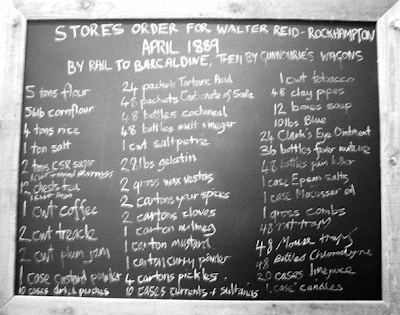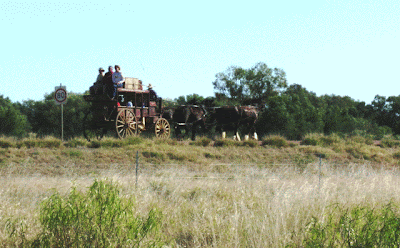We booked into the Longreach Caravan Park which was excellent. It was a very big site but with a most welcome large grassed area for tents. The facilities in this park were extremely good and made our stay very comfortable. We had some interesting neighbours in nearby tents. We spent the evenings together in the communal sitting/eating area swapping many tales over a glass of wine. One couple had come from Victoria and had been spending some time with friends on a property just outside Clermont. It turned out that the two men had been to school together. The couple from Clermont were interested to know that Dell was brought up on Roma Downs as he (Geoff Hurrey) had helped with the harvesting on Roma Downs when Dell’s Aunt Joan and son Alan were running the station. His friends, the Smith brothers, had also helped with the harvesting and were pleased to be able to make contact again with Alan Nolan.
The Stockman’s Hall of Fame kept us entertained for a full day. It has a huge amount of information. Unfortunately some of the lighting made reading the information difficult. Much of the audio commentary was obscured by background noise reflecting and concentrating from the hard surfaces. The most interesting audio commentary about traditional owners by elder John Gorringe was almost impossible to hear even kneeling down with our ears next to the speaker. We did note that different tribes used tools in different ways. Some tribes used the returning boomerang to guide flocks of birds into nets strung between trees. In this case the boomerang was not intended to hit anything but to return to the thrower. Other tribes used the boomerang to hit birds in flight and if the boomerang missed it returned to sender. However there were so many variations and opinions that it was hard to check the provenance of the answers.
Richard talking with a stockman.
The “Walking Together” bronze statue honours the memory of pioneer women. Two girls of indigenous and non-indigenous heritage are depicted walking together in friendship. The winds of change blow in their hair and skirts as they look towards the potential of the future with confidence. Following the patterns of circles once drawn in the Earth as an aid to conversation and storytelling, they walk barefoot in the footsteps of past generations of pioneer women.
After the Hall of Fame we enjoyed a walk back through the 2.5km Longreach Botanic Walkway. The garden displays and interprets the native plants of the Mitchell Grass Downs bioregion and demonstrates the potential of local dry land species for use in homes and parklands. There is a strong focus on waterwise techniques. Information on the name plaques included water needs, flowering, soil type and uses.
The QANTAS Founders museum was equally interesting and really well put together. However we were starting to feel ‘over museumed’ so we headed for greener pastures.
Iningai Nature Park
Just south of Longreach there is the Iningai Nature Park. It was named after the Iningai Traditional Owners who lived along the Thomson River from Stonehenge to Muttaburra before European occupation. When the European settlers arrived they cut down most of the mature coolabah and gidgee trees for firewood. They also grazed goats, horses and cattle up until the 1950s. The area has started to recover from the damage caused by domestic animals and refuse dumped by people. It has some great walks. We sat under the shade of a coolabah tree to enjoy the wild life.
The local council have started to replant trees and shrubs indigenous to the area and erect information plaques about each type.
We also came across two large male kangaroos having a boxing match. They were pretty feisty with each other. Once the winner had chased his competitor away he turned his attentions to a small female. She seemed more interested in eating grass.
Whilst we were on our walk the local Cobb & Co coach came by keeping to the speed limit.
Longreach sits on the Tropic of Capricorn.































